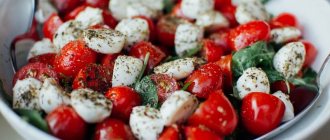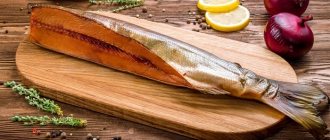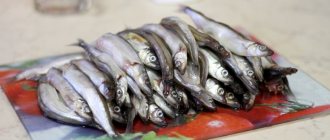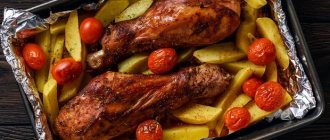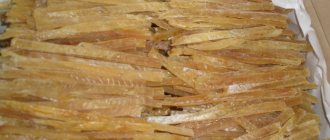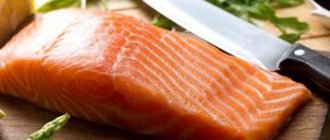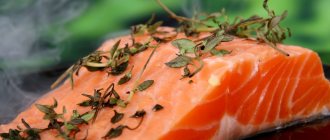Seafood and fish have played an important role in human nutrition since ancient times. Even the ancient Assyrians and Romans grew fish in ponds. For thousands of years, the Chinese have used their rice fields, when they are underwater, to breed fish. At different times, people ate both fresh and smoked and salted fish. And salmon has always occupied a special place in the diet of many peoples. For Scandinavians, British and Russians, this fish is part of their national cuisine.
Appearance
Salmon has certain appearance parameters by which it can be easily distinguished from other varieties. The body length can vary: from a few centimeters to a meter or more. Weight also depends on these indicators and can be several tens of grams or exceed 50 kg. In body structure, salmonids resemble herrings, since the body is significantly elongated and compressed at the sides. The scales of this variety can be cycloid or round with comb edges, which makes them easy to clean.
The pelvic fins are located in the middle of the belly and have a multi-rayed structure. The pectoral fin is low-slung and does not have spiny rays. The dorsal fins are a pair of true and anal fins that follow each other. A distinctive feature is the presence of an adipose fin, which is small in size, but this is precisely what makes it possible to distinguish fish from the order Salmonidae. The salmon's mouth has an upper border and four bones: two premaxillary and two maxillary.
If we talk about salmon, its appearance is also characterized by its considerable size, often reaching up to one and a half meters, and a weight of 40-50 kg, and the fish that is usually caught for sale weighs about seven to ten kilograms. Among the appearance features are:
- silver color;
- large scales;
- absence of stripes on the body;
- a head of medium length and pointed shape;
- elongated body shape.
During the spawning period, salmon stops feeding and lives only from the reserves made earlier, therefore, to reproduce, it enters the waters beautiful, silvery, with a light back, and after this process, except for caviar, it loses its attractiveness. The head and back become darker; instead of a silvery color, the fish becomes dull and has a purple tint. In addition to external indicators, body weight also changes, which decreases by half.
On store shelves you can see not only different varieties of salmon and salmon, but also fish caught from reservoirs and those that were artificially grown.
Why does salmon help you lose weight?
Contains a lot of protein. 100 g of salmon contains 21 g of protein. Therefore, salmon is very nutritious and perfectly satisfies hunger. In addition, protein accelerates metabolism and helps build muscle mass. Research has shown that a diet based on high-quality protein and fiber helps you lose weight quickly.
Low calorie. Salmon is low in calories: for example, a 125 g serving of fish contains only 206 calories. For low-fat salmon, this figure is even lower: 182 kcal.
Salmon is a source of omega-3. When compared to other seafood, this red fish has the highest concentration of omega-3 fatty acids. Scientists have proven that these acids help lose weight and maintain a healthy body. They reduce the risk of cardiovascular diseases, improve the condition of skin, hair and nails. To supply your body with enough omega-3, you need to eat 240-250 g of salmon per week.
Nutritional value and calorie content of salmon
Salmon is a protein product. Like Omega-3 fat, protein is an essential macronutrient that a person should get from their diet.
It plays important roles in the body, including helping to recover from injury, protecting the skeletal system, and maintaining muscle mass during aging and weight loss.
Another property of fish is as follows. Additionally, tryptophan, found in salmon, is a source of seratonin, which may help combat depression.
Additionally, since this fish is an excellent source of vitamin D, eating it may also help improve your mood, protect against macular degeneration, and aid in bone health.
One piece of salmon weighing 125 g contains 22 - 25 g of protein. The calorie content of a serving of this size will be 185 kcal, which is not that much. This product contains 0.9 g of saturated fat, and 3.6 g of unsaturated compounds with healing properties. It does not contain carbohydrates. Therefore, the benefits of salmon for pregnant and lactating women are undeniable.
Important! The human body needs proteins to maintain bones and prevent muscle loss. Salmon provides 22 - 25 g of protein per 125 g.
How many calories are in salmon?
So what exactly is the calorie content of this fish? And here it is:
Calorie content of fresh salmon is:
201 kcal per 100 grams of product
Proteins, fats and carbohydrates (BJU) of fresh salmon per 100 grams:
Proteins - 19.9
Fats – 13.6
Carbohydrates – 0.0
How many calories are in this fish, cooked in different ways? Here's how much:
Table of caloric content of salmon (BJU), per 100 grams of product:
| Product | Calories, in kcal |
| calorie content of baked salmon | 203,6 |
| steamed salmon calories | 190,0 |
| smoked salmon calories | 162,0 |
| calorie content of boiled salmon | 153,6 |
| salted salmon calories | 269 ,0 |
| fried salmon calories | 204,68 |
| Grilled salmon calories | 283,0 |
And the nutritional value of this fish, prepared in different ways, is this:
Salmon nutritional value table (BZHU), per 100 grams of product:
| Salmon | Squirrels, gr. | Fats, gr. | Carbohydrates, gr. |
| baked | 16,29 | 14,86 | 0,0 |
| for a couple | 21,6 | 11,5 | 0,0 |
| smoked | 21,5 | 8,4 | 0,0 |
| boiled | 20,2 | 9,22 | 0,0 |
| salty | 21,0 | 20,5 | 0,0 |
| fried | 22,9 | 12,0 | 0,0 |
| Grilled | 20,7 | 22,3 | 0,0 |
Vitamins and minerals in salmon
Salmon is one of the most nutritious foods. This healthy fatty fish is simply loaded with nutrients, so it can minimize risk factors for a number of diseases. Plus, it's delicious, versatile, and widely available.
Salmon is one of the best sources of Omega-3 fatty acids EPA and DHA. Each one hundred gram serving of farmed salmon has 2.3 g of these compounds, while a similar serving of wild salmon has 2.6 g.
Unlike other fats, Omega-3 fats are known as “essential” fats, meaning everyone is recommended to get them from their diet because the body cannot create them itself.
DHA and EPA are credited with several benefits to the body, such as reducing inflammation, lowering blood pressure, lowering cancer risk, and improving arterial cell function.
In addition, the benefits of salmon for humans are explained by the considerable level of B-vitamins. One hundred grams of the product contains the following quantities:
- B1 (thiamine): 18% DV;
- B2 (riboflavin): 29%;
- B3 (niacin): 50%;
- B5 (pantothenic acid): 19%;
- B6: 47%;
- B9 (folic acid): 7%;
- B12: 51%.
These vitamins are involved in several global processes in the body, including converting food into energy, creating and repairing DNA, and reducing inflammation, which can lead to heart disease.
All B vitamins have been found to work together to support optimal brain and nervous system function.
Important! Salmon fish is an excellent source of several B vitamins, vital for creating energy, fighting inflammation and protecting blood vessels and the brain.
Among other things, salmon are a good source of potassium. This is especially true for wild salmon, which provides 18% of the daily value in one hundred grams. This mineral controls blood pressure levels, thereby reducing the risk of stroke. Therefore, the benefits of salmon are especially important for men over 50 years of age.
Fish has a high percentage of selenium. It has been proven that this mineral protects the health of the skeletal system, alleviates thyroid diseases and prevents cancer.
Salmon contains astaxanthin, a compound that provides significant health benefits. Since it is an antioxidant from the carotenoid group, it is what gives the fish its red tint.
Astaxanthin reduces the risk of heart disease by lowering LDL (“bad”) cholesterol and increasing HDL (“good”) cholesterol. It is believed that the substance tends to react with Omega-3, protecting the brain and nervous system.
BJU salmon caviar
This is a favorite product of many of us. However, the consumption of salmon caviar should be limited to 5 teaspoons per day. Otherwise, digestive problems will arise, since the product includes a large percentage of amino acids, proteins, fats, and a lot of calories. The KBZHU of a 100-gram portion of salmon caviar differs in the following indicators:
- calorie content – 263 Kcal (17.14%);
- proteins – 32 g (34.78%);
- fats – 15 g (22.39%);
- carbohydrates – 0 g (0%).
Salmon caviar contains the same amount of vitamins D, E, group B, minerals - selenium and phosphorus, as in milk. But it contains much more Omega-3 (183.5%) than other parts of fish. This polyunsaturated fatty acid is considered essential because it is not produced by the body itself, but comes from food. Omega-3s normalize lipid metabolism, reduce cholesterol levels, preventing the formation of plaques, improve vascular elasticity, and promote proper digestion.
So, salmon is a healthy fish, from which you can prepare many delicious dishes, delighting yourself and your loved ones. Eating salmon prevents the development of pathologies of the heart, thyroid gland, mental disorders, and also gives beauty and prolongs youth.
Description and types of salmon
Salmon is the common name for several species of fish in the genus Salmoniformes. They live in the northern Atlantic and Pacific oceans and are anadromous. This means that most salmon species are born in fresh water, migrate to the sea, and return to fresh water to spawn or spawn.
The appearance of salmon varies greatly from species to species. Some fish are silvery-blue in color, while others have black spots on their sides or bright red stripes. Most salmon maintain one color when they live in fresh water and then change it when they live in salt water.
The following types of fish are most often commercially caught:
- Chinook salmon (Oncorhynchus tschawytscha), also known as king salmon: considered one of the best species. This fish has a high fat content and has tender flesh that ranges in color from white to dark red.
- Coho salmon (Oncorhynchus kisutch) are sometimes called silver salmon because of their color pattern: the fish has bright red flesh and a slightly finer texture than Chinook salmon (but a similar flavor).
- Pink salmon (Oncorhynchus gorbusha) is the most common Pacific salmon, also called pink salmon. The fish has very light and aromatic meat. This type of salmon is low in fat. Pink salmon is often harvested for canning, but it can also be found on sale fresh, frozen and smoked.
- Sockeye salmon (Oncorhynchus nerka), or red salmon, has bright red-orange meat and a rich aroma.
- Salmon (Salmo Salar) or Atlantic salmon. While the Pacific Ocean is home to several species of salmon, this is the only one that lives in the Atlantic. Currently, this species is bred on farms, which is why it does not have a very good reputation.
- Chum salmon (Oncorhynchus keta), or “dog” salmon, received this name due to the unusual shape of its teeth. It is a small fish with pale pink flesh and lower fat content. It is usually canned or sold frozen.
- Trout (Oncorhynchus S. Fario) is a freshwater species of fish from the salmon genus. It is usually small in size and sold fresh or smoked.
Which milks are salmon milk?
In Korea, the product is served with spicy vegetables, and in Sicily - with noodles. Housewives in the post-Soviet space also prepare various nutritious and healthy dishes from fish testes.
This valuable species of marine inhabitants includes individuals with red meat and a characteristic stripe on the side.
The salmon family includes:
- pink salmon;
- salmon;
- red salmon;
- salmon;
- trout;
- grayling.
chum salmon;
Salmon fish milk
The milk of these fish is valued above other river, sea and ocean inhabitants. The volume of one salmon seminal gland can vary from 300 to 500 ml. The whiter the milk, the more sexually mature the individual from which it was extracted.
Beneficial features
- Salmon is easily digestible. Within an hour after taking it, beneficial substances are released to the body.
- Omega-3 fatty acid improves the functioning of blood vessels, reduces the risk of thrombosis and cardiovascular diseases
- Regulation of stress hormones helps relieve emotional stress and fatigue, prevent depression, increase performance and mental activity
- Salmon meat contains special fats that benefit a woman's figure, not harm. They control cholesterol levels and make blood vessels elastic by nourishing the walls. Healthy fatty acids in salmon meat promote weight loss. They do not harm the figure, since they are not deposited in the body in the form of fat deposits.
- Using salmon in the diet increases immunity, which reduces the risk of various diseases.
- Red fish meat benefits the appearance of girls. It strengthens nails and hair follicles, promotes rapid skin regeneration and acne healing.
- The content of methionine in fish prevents the development of diabetes mellitus and liver diseases.
- Salmon meat, rich in beneficial vitamins D and PP, is recommended for pregnant women. Their content improves the functioning of the bone skeleton of newborn children and prevents the occurrence of diseases such as rickets.
- The benefit of red fish in the human diet is the production of melatonin, which has protective properties from the sun and a rejuvenating effect.
- Salmon, thanks to the easily digestible amino acids it contains, is beneficial for men and women involved in sports. Red fish in the diet quickly restores muscle tissue and helps recover from injuries and illnesses.
- Salmon caviar is used by cosmetologists as a component of masks and creams for girls to restore skin condition.
- Vitamin B 6 allows men to solve the problem of infertility.
- Eating salmon in the diet is recommended for the health of women during menopause - vitamins and fatty acids allow the absorption of more calcium to prevent osteoporosis.
- Insulin, pancreatin and other drugs are obtained from salmon components.
- Red fish meat is useful in the complex treatment of diseases of the nervous and cardiovascular systems.
The benefits and harms of salmon caviar
Salmon caviar is not just a wonderful delicacy. It also has some outstanding benefits and health benefits. Thus, one tablespoon of caviar contains more than 1 gram of healthy unsaturated fats.
In addition, it is also an excellent source of vitamin B12, which is responsible for creating red blood cells and helping the body utilize fatty acids. Selenium, the benefits of which are undeniable, is also found in caviar. It works as an antioxidant in conjunction with vitamin E to protect cells from damage caused by free radicals and other compounds in the body that can lead to heart disease or cancer.
Caviar is also rich in vitamins A and E, which are essential for cell growth and a healthy immune system. A tablespoon of caviar contains about one-tenth of the daily value of these compounds.
Salmon roe is also high in protein and low in trans fats and carbohydrates, which can be harmful when consumed in excess. This delicacy is also rich in potassium, which lowers blood pressure. Potassium is also thought to help prevent the accumulation of kidney stones, and some migraine sufferers find it helps relieve symptoms.
The harm of salmon caviar may lie in the fact that it has high cholesterol levels. The sodium content of the product is another drawback. The caviar is soaked in a saline solution during processing, which increases the content of this substance. The properties of this product are identical to those of salted fish. The benefits of such salmon are not in dispute, but excess salt reduces it somewhat.
Recipes
In a frying pan.
Ingredients:
- 300 g salmon fillet;
- 2 tbsp. flour;
- 1 egg;
- 0.5 cups walnuts.
Cooking method:
- Crush the nuts and divide them into two parts.
- In a separate bowl, mix the flour and egg using a mixer and then add half the volume of nuts to the mixture.
- Wash and dry the salmon fillets before thoroughly soaking them in the nut and egg batter and rolling them in the nuts.
- Place the fish in the hot pan and cook for 4 minutes on each side. In this case, the heat should be low and the pan lid should be closed while frying.
Grilled.
Ingredients:
- 4 pieces of salmon steak;
- 3/4 cup green dill;
- 1 tbsp. tarragon;
- 1 teaspoon sugar;
- 1 teaspoon lemon zest;
- 1 tablespoon of unflavored vegetable oil.
Cooking method:
- Brush steaks with vegetable oil on all sides.
- Mix remaining ingredients in a separate dish.
- Place the fish in the resulting marinade for a quarter of an hour, then place the salmon on a hot grill and fry for 10 minutes, turning over.
On the grill.
Ingredients:
- salmon fillet 0.75 kg;
- 250 g brown sugar;
- 38 ml lemon juice;
- 63 ml olive oil;
- soy sauce 63 ml;
- 38 ml water;
- 2.5 cloves of garlic;
- salt.
Preparation:
- Combine all ingredients except fish in a tight plastic bag and mix thoroughly.
- Cut the salmon into 5 pieces and place in a bag.
- Thoroughly mix the fish with the marinade and place in the refrigerator for 3 hours.
- After the required time, place the fish on the grill and on the hot grill.
- Cook the dish for about 10 minutes, turning the salmon pieces occasionally.
In a steamer.
Ingredients:
- salmon fillet 0.4 kg;
- 5 g lemon zest;
- 5 ml lemon juice;
- 40 g rosemary;
- 0.6 l of water;
- Salt.
Preparation:
- Cut the washed fillet into 4 portions, add salt, sprinkle with lemon juice and sprinkle with zest, then leave for 7 minutes.
- Pour water into the slow cooker, adding rosemary.
- Place a special steam sieve on which to place the salmon.
- Switch the toggle switch to steam mode and cook the dish for about 15 minutes.
Trout with cheese
Fish and cheese are one of the most spectacular combinations in culinary history. To prepare two servings you will need the following ingredients:
- trout fillet - 600 g;
- curd cheese - 250 g;
- assorted hard cheeses (2-3 varieties) - 150 g;
- a bunch of greenery;
- juice of one lemon;
- salt, pepper - to taste;
- pine nuts - 50 g.
Cooking method:
- Clean the fish, rinse thoroughly and cut into thin strips 5 cm wide, sprinkle with lemon, salt and pepper and leave to marinate for 20 minutes.
- Finely chop the greens and mix with cottage cheese.
- Grease each layer of fish with a mixture of cheese and herbs and roll into a roll.
- Line a baking tray with baking paper, lay out the prepared rolls, sprinkle with grated hard cheese.
- Preheat the oven to 180 degrees. Bake for 30 minutes. Five minutes before readiness, turn on the convection mode.
- Crush the pine nuts with a rolling pin and sprinkle over the finished dish.
Calorie content of baked salmon with cheese per 100 g - 280 kcal
Salmon composition
So, let's see what substances salmon is rich in
. Salmon meat is an excellent dietary product. It has a lot of protein, little fat and no carbohydrates at all. Of the vitamins, it is especially rich in niacin (vitamin B3, PP). This substance has a beneficial effect on absolutely the entire body - the circulatory, nervous and digestive systems. It also normalizes metabolism and hormonal balance. Salmon is rich in vitamins B5, B6, B2, B1 and many others. Among the macroelements, potassium and phosphorus lead. These substances are known to be necessary for the functioning of the cardiovascular system, the development of muscle tissue and normal brain function. It also contains calcium, magnesium and sodium. Salmon meat contains a lot of microelements. It is especially rich in iron and zinc, and also contains manganese, copper and selenium.
Features of the keto diet: do's and don'ts
There is no single standard for the keto diet—only approximate macronutrient ratios. People who adhere to it usually consume less than fifty grams of carbohydrates per day - this is less than in the average pie - sometimes up to twenty grams and from this amount they build the rest of the ratio.
It is classically believed that if you consume two thousand calories a day, then you need to eat one hundred sixty-five grams of fat, forty carbohydrates and seventy-five protein.
Interestingly, the amount of protein in keto is moderate compared to other low-carbon diets - this is because excess protein can prevent ketosis. Amino acids in proteins can be converted into glucose, so in keto there is enough of it to maintain lean body mass - but no more.
There are many varieties of ketogenic diets, but they are all similar to each other in basic aspects.
They prohibit carbohydrate-rich foods. Most are obvious - refined and whole grain foods, i.e. pasta, bread, cereal, rice, cookies; starchy vegetables such as potatoes and corn; legumes; most of the fruit.
Foods high in saturated fat are allowed: fatty meats, processed meats, lard and oil.
Products high in unsaturated fats are also allowed: nuts, seeds, avocados, vegetable oils, fatty fish.
Depending on the type of keto, the lists may differ or even contradict each other, but they still usually recommend:
- Fats. These should be emphasized at any meal since fat is the most consumed on keto. Cocoa butter, lard, poultry fat, most vegetable fats (olive, palm, coconut oil), high-fat foods: avocado, coconut pulp, nuts (almonds, walnuts, macadamia, pecans), seeds (sunflower, pumpkin) are allowed , flax, sesame).
- Some dairy products. Some of them are an excellent source of fat, but others contain lactose sugars (for example, in cream and full-fat milk). Butter and hard cheeses are definitely allowed.
- Protein in moderation. The best foods for keto are beef (only meat from grain-free cows), free-range poultry (higher in omega-3 fatty acids), pork, bacon, wild fish, organ meats, eggs, tofu, and some nuts and seeds.
- Be sure to include non-starchy vegetables in your diet, such as: leafy greens (kale, spinach, lettuce), cauliflower, broccoli, Brussels sprouts, asparagus, bell peppers, onions, garlic, mushrooms, cucumbers, celery, zucchini.
- Berries. Although they contain carbohydrates, they have lower net carbohydrates* than fruits.
- Other: dark chocolate (at least ninety percent cocoa content), cocoa powder, unsweetened coffee, tea, vinegar and mustard (but not sauces based on them with added sugar), herbs and spices.
The following are expressly prohibited:
- All whole and refined flour products, sugars in any form (either naturally present in foods and drinks or added during production), starchy vegetables such as potatoes and corn.
- Fruits (the only exception is if they are included in the carbohydrate norm). Full fruit juices.
- Legumes, including beans and lentils.
Regarding alcohol, different versions of keto say different things: some exclude it altogether, some allow small amounts of strong spirits or low-carb wines, most prohibit the consumption of fully carbohydrate wines and beers, as well as any drinks with added sweeteners (cocktails, mixes with syrups) and juices, flavored alcohols).
What are “net carbs”?
The very phrase “net carbs” is iconic in ketogenic and diabetic diets. It means the amount of carbohydrates that are absorbed by the body after consumption and used to produce calories. This number is calculated by subtracting the amount of indigestible carbohydrates from the total. Indigestible carbohydrates are insoluble fiber from whole grains, fruits and vegetables; sugar alcohols such as mannitol, sorbitol and xylitol, which are commonly used in diabetic products.
However, these calculations are not strictly scientific and are not always accurate, since the effect of sugar alcohols can vary depending on many factors and it is better to limit foods with carbohydrates as much as possible in principle.
Generally, it is not expected that a person will stick to the keto diet for life. It is enough to get to your desired weight, and then follow the diet for a few days a week or a few weeks a month to prevent it from gaining back.
Cooking salmon at home
Salmon has healthy and tasty meat that is easy to cook. It is delicious baked, pan-fried or grilled, added to salads and pies, and so on. To maximize the health benefits of salmon and reduce harm, it is advisable to use fat-free cooking methods.
Salmon in cream sauce
Most salmon recipes suggest eating it with the skin on. But to get the maximum benefit from the product, it is better not to use it. To make salmon in cream sauce really tasty, you need to use thick, heavy cream.
One of these recipes requires:
- 3 tbsp. l. lemon juice;
- 1/4 cup chicken or fish broth, or white wine, or water;
- 2/3 cup heavy cream;
- 1 tbsp. l. frying oils;
- salt;
- freshly ground black pepper;
- 700 g salmon fillet;
- parsley for garnish.
We recommend reading: The benefits of white wine and how to make it at home
Sequencing:
- Prepare lemon cream sauce. To do this, pour the lemon juice, broth and cream into a small saucepan and bring to a boil.
- Reduce the temperature to low, cover the pan and simmer gently for 10 minutes, adding salt and pepper.
- At the last minute or two, open the pan and increase the cooking temperature to thicken the sauce a little.
- While the sauce is preparing, rinse the salmon in cold water and pat dry with paper towels.
- Pour oil into a saucepan and heat it over high heat for 90 seconds.
- Then the fillet is placed in a saucepan.
- Fry it for 3 - 5 minutes, depending on the thickness of the fish. A 3cm thick fillet will take about 5 minutes to cook.
- Using a metal spatula, turn and cook for another 1 to 5 minutes.
We recommend reading: Chili peppers: benefits and harms, properties, how to eat them
The finished salmon fillet is placed in a deep plate and poured with hot sauce. To decorate, sprinkle chopped parsley on top.
Salting salmon
For salting, raw fish is placed in a mixture of salt and sugar. The process continues for 4 days in the refrigerator, after which the lightly salted salmon is thinly sliced and eaten cold.
It is usually served as an appetizer, but is also great on sandwiches or as a main dish. Cured salmon has a similar flavor to smoked salmon, but has a firmer texture. In addition, this method of cooking produces much less harm and more benefits, since the processing of lightly salted salmon is minimal.
For the salmon pickling recipe you will need:
- salmon fillet – 500 g;
- 2 tbsp. l. salt;
- 2 tsp. Sahara.
If the salmon fillet is thicker than 1.5 cm, it is better to cut it into 2 layers.
The salmon is placed in a glass dish, sugar and salt are rubbed into it on all sides.
Cover the container with a lid, place it in the refrigerator and leave it to salt for 4 days, after which the salted salmon can be eaten.
Which foods contain the most protein?
High protein content can be easily found in the following foods:
- Beef contains a lot of protein. It is best to choose meat no older than two years. Beef should be boiled or stewed, so the body will receive maximum benefits.
- Liver is an important by-product for humans, enriching the diet with protein. It is better to eat it boiled or in the form of pates.
- Poultry – in addition to easily digestible protein, poultry meat is low in calories.
- Eggs - the protein from this product is perfectly absorbed in the body. Two eggs provide 17 g of protein.
- Cheese contains a lot of valuable building elements, but it is characterized by high calorie content.
- Cottage cheese - for better protein absorption, use with yogurt or kefir with the addition of a small amount of sugar.
- Fish is rich in protein and is easily digestible. It is better to choose anchovies, tuna, mackerel, sardines, salmon, mullet, and pollock.
- Brussels sprouts are the leader among vegetables in protein content.
- Soy is a plant-based meat substitute.
Cereals – promote good digestion, are easily digestible, and contain vegetable protein.
List of plant-based protein products
Essential acids, which are components of pure protein, are also found in plant foods. Soy is an excellent source of plant-based protein. The product is fat-free, which has a beneficial effect on the liver. Soy protein is absorbed almost completely. Beans, other legumes and grains are also an excellent alternative to meat. Buckwheat is in first place among cereals; it is rich in iron and vitamins, and has a positive effect on hematopoietic function. Bran and oats contain protein, normalize blood pressure and remove cholesterol.
If you have given up animal foods and become a vegetarian, you should replenish your vitamin B12 reserves. It takes an active part in metabolic processes and the activity of the nervous system. As an alternative, choose baker's and brewer's yeast, seaweed, green salad, green onions, and spinach. These are excellent sources of plant-based protein.
List of protein products of animal origin
Proteins of animal origin are the most complete, therefore their quality indicators are higher. Consumption of animal proteins has a positive effect. Their entry into the body of pregnant women in the later stages guarantees the birth of a child with a normal weight. Positive reactions from protein consumption have also been observed in older people. The daily protein intake is 1.5 grams per kg of weight. What foods contain protein?
In meat dishes we can find the maximum amount of proteins. Depending on the variety, their content varies from 17 to 21%. Meat is rich in mineral elements, vitamins and water. It is imperative to consume poultry, beef, lamb or pork, as they promote recovery processes. The rabbit is a valuable supplier of building elements. Game and chicken are better broken down by the digestive tract. Protein from fish and seafood is also very valuable. Fermented milk and dairy products are rich in calcium and protein.
Table of foods containing high amounts of protein
Since protein is considered the basis of life, it is necessary to eat foods containing large amounts of it every day. The diet should consist of at least 30% protein. The table below shows a list of products from which you can get this essential element. It presents different varieties of meat, fish and dairy products, which will also enrich your diet with useful minerals and vitamins.
Table of protein content in food
| Product | Amount of protein | Amount of fat | Amount of carbohydrates | Calorie content, kcal |
| Goose meat | 29 | 22 | – | 319 |
| Chicken | 25 | 6 | – | 150 |
| Lamb meat | 24 | 25 | – | 300 |
| Lean beef | 20,2 | 7 | – | 168 |
| Rabbit | 24 | 9 | – | 181 |
| Lean pork varieties | 25 | 28 | – | 226 |
| Beluga | 24 | 4 | – | 131 |
| Chum salmon caviar | 27 | 13,4 | – | 261 |
| Mullet | 21,4 | 4,3 | – | 85 |
| Cod liver | 24 | 66 | – | 613 |
| Cow's milk 1% | 33 | 1 | 0,2 | 5,1 |
| Hard cheese | 30 | 30 | Up to 4 | 300 |
| Brynza | 18 | 20,1 | 260 | |
| Cottage cheese | 16 | 0,6 | 1,6 | 88 |
| Kefir | 3 | 1,0 | 4 | 30 |
| Sour cream | 1,5 | 48,2 | 2 | 447 |
| Processed cheese | 20 | 20 | 3,8 | 271 |
The benefits and harms of smoked salmon
Smoked salmon has beneficial and harmful properties. Like fresh, it is a good source of protein, vitamins B and D, magnesium and selenium. High amounts of DHA and EPA help reduce the risk of heart disease and prevent macular degeneration and Alzheimer's disease.
On the other hand, smoked salmon has a higher dose of sodium. For example, 120 g of the product contains 666 mg of sodium, which is more than one-third of the daily value.
Before fish is smoked, it is treated by adding salt in the form of brine (a mixture of salt, water and spices) or salt crystals. Salt reduces the moisture content of salmon, which helps extend its shelf life. It also helps prevent the growth of germs that can cause food poisoning.
Most smoked salmon is cold smoked, meaning it is cooked at a temperature that is not hot enough to kill potentially harmful bacteria. Therefore, there may be harm from Listeria monocytogenes, a bacteria that can cause rare but serious food poisoning, especially among pregnant women, the elderly and people with weakened immune systems.
Hot smoked salmon is lighter in color and more fluffy. It is processed at a temperature of about 80 °C and is completely ready for consumption. Despite the heat treatment, it can also cause harm if technological processes are disrupted.
There is also concern that eating smoked foods may increase the risk of cancer. Smoked salmon contains nitrates and nitrites, by-products of smoking. Their harm lies in the fact that they can be converted in the body into N-nitroso compounds, which are carcinogenic. Thus, there are both benefits and harms of smoked salmon for the body.
Daily diet for weight loss
Properly separating meals and controlling portions can help you lose weight. It is better to plan your meals in advance and follow the regimen daily:
- Be sure to have breakfast.
- Avoid feeling hungry. Need a snack. If the body feels a shortage of food, it will store fats. You can explore snack recipes to help you lose weight or maintain an already healthy weight.
- Any dishes should be complete and not poor in composition.
- You need to eat in small portions and often.
- Include physical activity and training in your daily routine.
Recipes for proper nutrition (RP)
It’s not difficult to prepare healthy recipes using photos, and each of them can become an excellent example of healthy eating and lead to weight loss.
1. Pasta with chicken and vegetable side dish. Take durum pasta and cook without salt. Cut a medium-sized zucchini into cubes, add green beans and broccoli. Other vegetables are also possible. Stew in soy sauce. Cut the chicken breast into small pieces and add to the stewed vegetables. Mix all ingredients and add to pasta. You can serve vegetables with chicken and pasta separately.
2. Fish with sauce Prepare the sauce: combine a few tablespoons of low-fat sour cream or unsweetened yogurt without additives with a pinch of nutmeg and black pepper. Grind the pickled cucumber, add a small spoon of mustard and mix with sour cream. It is better to buy white, sea fish. For example, cod, halibut, tilapia. Remove skin, backbone and bones to create a clean, even fillet. Sprinkle with lemon juice and bake in the oven. You can add vegetables to the fish. Pour white sauce over top.
3. Zucchini stuffed with cheese. Divide medium zucchini in half lengthwise and scoop out the pulp. Finely grate the cheese, mix with vegetable pulp, chopped garlic and herbs. Fill each of the boats with this mass. Cut the cherry tomatoes in half and stuff the entire length of the zucchini. For beauty, you can decorate the top with greenery.
Diet for weight loss
To begin with, you can keep a healthy eating diary in which you will enter the main foods you eat during the day.
First day.
- Breakfast: Hercules or oatmeal porridge, boiled in water.
- Lunch: stewed chicken breast with vegetables. Durum wheat pasta is suitable as a side dish.
- Dinner - Vegetable stew.
- Throughout the day you can have snacks - dried fruits, bread with red fish or cottage cheese.
Second day.
- Breakfast - Vegetable salad, a slice of whole grain bread with tomato and cheese.
- Lunch - vegetable casserole of vegetables, cheese and eggs.
- Dinner - Brown rice with squid (or fish).
- During the day you can eat an apple, a piece of whole grain bread with cottage cheese.
The third day.
- Breakfast - Buckwheat porridge cooked in water.
- Lunch - Vegetable soup.
- Dinner - Boiled beef and stewed zucchini (cabbage).
- During the day you can eat nuts, or drink a glass of kefir.
Fourth day.
- Breakfast - Cottage cheese with sour cream and fruit.
- Lunch - Chicken stewed with buckwheat.
- Dinner - Omelette with vegetables.
- Snacks: oatmeal cookies, dried fruits.
Fifth day.
- Breakfast - Fruit salad dressed with unsweetened yogurt.
- Lunch - Buckwheat soup with vegetables.
- Dinner - Cottage cheese casserole, cabbage and carrot salad.
- Between meals you are allowed to drink a glass of low-fat kefir and eat an apple.
Sixth day.
- Breakfast - Millet porridge.
- Lunch - Vegetable or cottage cheese-fruit casserole.
- Dinner - Boiled sea fish and brown rice.
- Snack - Bread sandwich with fish and a slice of cucumber.
Seventh day.
- Breakfast - Rice porridge.
- Lunch - omelet with chicken.
- Dinner - salad of raw beets, cabbage, carrots and boiled beef.
- Kefir and nuts are suitable as a snack.
Salmon with lemon
The calorie content of salmon baked in the oven greatly depends on the sauce and marinade in which it was cooked. To prepare salmon according to the basic recipe you will need:
- salmon cut into steaks - 700 g;
- juice of 1 lemon;
- salt, pepper - to taste.
Squeeze juice from lemon. To make this easier, you can warm the lemon in the microwave for 30 seconds. Place the fish on a baking sheet on foil or baking paper and sprinkle with lemon juice. Salt and pepper. Heat the oven to 200 degrees and bake the fish for 25 minutes.
A cooking option is to bake it in foil - then the fish will turn out incredibly tender. Each individual steak needs to be wrapped in foil, and five minutes before it’s ready, unfold it and turn on the convection mode - this will give the salmon a crispy, delicious crust.
The calorie content of the finished dish per 100 g is 180 kcal.
conclusions
In order for salmon dishes to be truly dietary and bring maximum benefits, it is necessary to follow the cooking technology. Indeed, in the best case, an incorrectly prepared dish can have a high calorie content and do not correspond to dietary status, and in the worst case, non-compliance with the rules for heat treatment of fish or the use of low-quality products can lead to severe food poisoning.
It must be remembered that dietary food should be dietary in everything. That is, if you spent a lot of time preparing a low-calorie salmon fillet dish, but there will be unhealthy food on the table as an appetizer or dessert, then the diet will lose any meaning.
